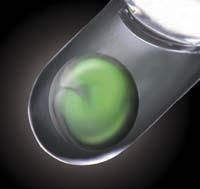Stem cells create a retina in the laboratory

The retina is the most complex tissue created to date
At the RIKEN Development Biology Center in Japan, a three-dimensional structure of the retina has been created in the laboratory, as well as adequately differentiating each structural cell. All this from the embryonic stem cells of mice. The transformation of stem cells already acquired into cells of various organs and tissues, even ocular. Now the stem cells have managed to create a complete structure of the eye: the optical dome. The research has been published in the journal Nature.
The optical dome is created before the development of the eye in the embryos of the vertebrates. It is a two-layer cup structure. As development progresses, the outer layer (the closest to the brain) is transformed into a pigmented cell of the retina and the inner layer into a sensory layer of the retina. In this second, light sensitive cells appear, which send information from light to the brain, etc.
To make stem cells become optical domes, researchers used a breeding medium called matrigel, which pushes them to become eye cells. Thus, they observed that the cells initially formed a viscous liquid that gradually developed in the next few days and that they had the development observed in the embryos until forming the optical dome.
Despite the anatomical formation of the structure, researchers point out that they have not yet tested whether the optical dome is sensitive to light.





